Balkinization
an unanticipated consequence of
Jack M. Balkin
Balkinization Symposiums: A Continuing List
E-mail:
Jack Balkin:
jackbalkin at yahoo.com
Bruce Ackerman
bruce.ackerman at yale.edu
Ian Ayres
ian.ayres at yale.edu
Corey Brettschneider
corey_brettschneider at brown.edu
Mary Dudziak
mary.l.dudziak at emory.edu
Joey Fishkin
joey.fishkin at gmail.com
Heather Gerken heather.gerken at yale.edu
Abbe Gluck abbe.gluck at yale.edu
Mark Graber
mgraber at law.umaryland.edu
Stephen Griffin
sgriffin at tulane.edu
Jonathan Hafetz
jonathan.hafetz at shu.edu
Jeremy Kessler
jkessler at law.columbia.edu
Andrew Koppelman
akoppelman at law.northwestern.edu
Marty Lederman
msl46 at law.georgetown.edu
Sanford Levinson
slevinson at law.utexas.edu
David Luban
david.luban at gmail.com
Gerard Magliocca
gmaglioc at iupui.edu
Jason Mazzone
mazzonej at illinois.edu
Linda McClain
lmcclain at bu.edu
John Mikhail
mikhail at law.georgetown.edu
Frank Pasquale
pasquale.frank at gmail.com
Nate Persily
npersily at gmail.com
Michael Stokes Paulsen
michaelstokespaulsen at gmail.com
Deborah Pearlstein
dpearlst at yu.edu
Rick Pildes
rick.pildes at nyu.edu
David Pozen
dpozen at law.columbia.edu
Richard Primus
raprimus at umich.edu
K. Sabeel Rahmansabeel.rahman at brooklaw.edu
Alice Ristroph
alice.ristroph at shu.edu
Neil Siegel
siegel at law.duke.edu
David Super
david.super at law.georgetown.edu
Brian Tamanaha
btamanaha at wulaw.wustl.edu
Nelson Tebbe
nelson.tebbe at brooklaw.edu
Mark Tushnet
mtushnet at law.harvard.edu
Adam Winkler
winkler at ucla.edu
Compendium of posts on Hobby Lobby and related cases
The Anti-Torture Memos: Balkinization Posts on Torture, Interrogation, Detention, War Powers, and OLC
The Anti-Torture Memos (arranged by topic)
Recent Posts
Law, Organizing (and Philanthropy) in the Radical Fund
Just A Few Blogs
ACS Blog
Alas, a Blog
Althouse
Arts and Letters Daily
Atrios (Eschaton)
Bill of Health
Buzzflash.com
Buzz Machine
Cato at Liberty
Juan Cole (Informed Comment)
Concurring Opinions
The Constitution in 2020
Corrente
Crooked Timber
Daily Howler
Daily Kos
Dana Boyd
Brad DeLong
Digby (Hullabaloo)
Discriminations
Daniel Drezner
Kevin Drum (Mother Jones)
Electrolite
En Banc
Eunomia (Daniel Larison)
Fafblog
Michael Froomkin (Discourse.net)
GovLab (Beth Noveck)
Rick Hasen (Election Law)
History News Network
How Appealing
Ignatz (Sam Heldman)
The Importance of (Ernie Miller)
Infolaw
Instapundit
International Economic Law and Policy Blog
IntLawGrrls
Jacob Levy
Jesus' General
Jurisdynamics
The Kitchen Cabinet
Mark Kleiman
Law Blog Central
Larry Lessig
Lawyers, Guns and Money
Liberal Oasis
Brian Leiter's Law School Reports
The Leiter Reports
Marginal Revolution
Megan McArdle
Memeorandum
Metafilter
Mirror of Justice
The New Republic
Newseum
No More Mister Nice Blog
Brendan Nyhan
Opinio Juris
Orcinus
The Originalism Blog
Pandagon
Passport (Foreign Policy)
Overcoming Bias
Political Animal (Washington Monthly)
Political Theory Daily Review
Political Wire (Taegan Goddard)
The Poor Man
Virginia Postrel
Prawfsblawg
Public Reason
Jonathan Rauch
Raw Story
Redstate
ReligiousLeftLaw.com
Reporters Committee For Freedom of the Press
Reproductive Rights Blog
Rothman's Roadmap to the Right of Publicity
SCOTUS Blog
Seeing the Forest
Clay Shirky
The Shifted Librarian
The Situationist
Larry Solum (Legal Theory)
Andrew Sullivan
Talking Points Memo
Talk Left
Tapped
Tbogg
TechPresident
The Paper Chase (Jurist)
Tom Paine
Tom Tomorrow (This Modern World)
Eve Tushnet
Uggabugga
University of Chicago Law School Faculty Blog
Unqualified Offerings
The Volokh Conspiracy
War and Piece (Laura Rozen)
Wampum
Oliver Willis
Wonkette
Written Description
Matthew Yglesias
Yin
Your Choice of Feeds
1. XML
powered by
2. Atom Feed
3. RSS 2.0
Law, Organizing (and Philanthropy) in the Radical Fund
Guest Blogger
For the Balkinization symposium on John Witt, The Radical Fund: How a Band of Visionaries and a Million Dollars Upended America (Simon and Schuster, 2025).
Benjamin
Sachs For anyone
interested in the contemporary labor movement, and in efforts at revitalizing
it, John Witt’s The Radical Fund is important reading. Indeed, the book is
uncanny in its relevance for contemporary labor movement trends, challenges,
and opportunities. One obvious way this is true goes to the core of the book’s
project: the contest in the early 20th century over the role of
philanthropy in supporting the labor movement, related with masterful
storytelling, sheds light on those same questions in contemporary practice. Indeed,
there are concrete lessons to be learned here. To take one example, the
importance of Brookwood Labor College (nearly forgotten today) to the sweep of
labor activism across these years – from the role it played in realizing Sidney
Hillman’s new unionism to the contribution it made to the success of the
sit-down strikes of the 1930s – suggests that philanthropic support for a
re-imagined system of labor education should be higher on philanthropy’s agenda
today. But it is
another aspect of The Radical Fund that I want to highlight: namely, the
history the book tells about the relationship between law and worker organizing.
This question of how law and organizing relate has been the focus for a set of
legal scholars over the last few decades and is now the subject of an extensive
body of scholarship. In addition to other essential historical work on the
subject, early works in the “law and organizing” literature proper include
Scott Cummings and Ingrid Eagly’s A Critical Reflection on Law and
Organizing and Jennifer Gordon’s book We Make the Road by Walking.
More recent work includes Greg Balz’ writing (e.g., Resurrecting the Rent
Strike Law), Cummings and Elmore’s Mobilizable Labor Law and a pair
of articles by Kate Andrias and me (Constructing Countervailing Power and
The Chicken-and-Egg of Law and Organizing) along with critiques of that
work like Catherine Fisk’s The Once and Future Countervailing Power of Labor.
The animating question in all this scholarship is how law can best be
understood and deployed by organizers to build power with and for workers. Reading
Witt’s book, I was first struck by the bare fact that this question – the law
and organizing question – was explicitly a subject of debate in the early 20th
century world that Witt brings to life. Organizers and movement leaders argued
over the question, philanthropists running the Garland Fund struggled over it,
and movement lawyers took divergent positions on it. The fact that the
question, which animates law and organizing scholarship today, was central to
the thinking of labor movement players in the early 20th century –
in the heyday of the labor movement – reaffirms that the question is one with
major stakes. But, beyond
this, the book animates three different conceptions of the relationship between
law and organizing, which are helpful in thinking about the problem today. I’d
categorize those conceptions as: (1) law is and always will be a disaster for worker
organizing because law is a tool of class power and cannot be used to shift
power; (2) while law is most often used to suppress organizing, it can also be
deployed as a useful locus around which organizing campaigns can be built; and (3)
law can be useful, not as a tool for organizing, but as an architecture for building
lasting institutions into which the energy of organizing can be channeled and
thereby preserved. The first view
of the relationship between law and organizing is the most familiar and the
most straightforward. On this view, law is a product of class power and can be
expected to reproduce class relations. The idea of using law to facilitate organizing
by workers against employers amounts to something like a category error. On
Witt’s account, this was essentially the view of The Fund’s central
protagonist, Roger Baldwin. Thus: Baldwin
suspected that expanding the state’s apparatus would undermine labor’s real
power. At the heart of his opposition lay a sense, as the ACLU’s resolution
against the Wagner Act put it in 1934, that workers’ rights were enforceable by
‘economic power and organized labor alone.’ ‘Capitalist courts,’ as Dunn and
Michaelson put it, would never deliver class justice. It was at
times also the view that A. Phillip Randolph expressed: “Randolph,” Witt writes,
“had once protested the ‘entire warp and woof and fabric of American law’; he
had scorned the law for its spirit of inequality, injustice, and prejudiced
administration.” And perhaps of greatest import, this was in large measure the
view of the American labor movement for much of the era: For
a generation, the principal strategy of labor unions in the courts had been
defensive: to protect workers from the injunctions issued at the behest of
employers. The ‘best thing the state can do for labor,’ wrote Samuel Gompers in
1901, ‘is to leave labor alone.’ The radical wing of the American Fund . . .
offered a left-wing version of the same defensive strategy. The injunction
problem, fund trustee Scott Nearing proposed, was proof of ‘the conflict theory
of the state.’ ‘It should be taken for granted,’ Nearing explained, ‘that the
capitalist state is against labor.’ But the
allergic posture toward law was not the only one embraced by the Fund and its
participants. Witt also excavates a second view of the relationship, a less
obvious and more nuanced view, that will be familiar to contemporary law and
organizing scholars, even though the historical antecedents that Witt develops are
new. Witt describes this second view as involving the use of law “to create
focal points for organizing.” Jennifer Gordon and Francesca Polletta, among
others, have described law as functioning in similar ways in contemporary
settings. Writing about recent organizing by garment workers in New York, I
have pointed to the ways the law can serve as the “locus of workers’
organizational activity.” Witt’s
primary example of law as a focal point for organizing is Randolph’s campaign
to organize the Pullman Company’s sleeping car porters. While the organizing
effort was far broader than this, Witt explains how Randolph deployed a
three-pronged legal strategy to focus and advance the organizing campaign.
First, Randolph sought to have the National Mediation Board – created under the
then recently-enacted 1926 Railway Labor Act – certify the union (the
Brotherhood of Sleeping Car Porters) as the legitimate collective
representative of Pullman porters. Second, the union asked the Interstate
Commerce Commission to ban tipping on the railroads. The legal theory was that,
by allowing tipping, the railroads were imposing a hidden charge; the
organizing idea was that by making porters reliant on tipping, the railroads
were effectively requiring them to work without sleep for the multi-day
duration of a railroad trip. And third, the union sued Pullman seeking to
prohibit the company from holding an election for a company union, on the
ground that such a procedure would interfere with the Brotherhood’s RLA right
to represent the porters. The legal strategy was not successful – either in
securing legal victories or in galvanizing much organizing – at least not in
the short run. And it would be helpful (though, of course, maybe not possible)
to know more about how Randolph used these legal tools to focus the organizing
efforts. But the campaign clearly stands as an early antecedent to one of the
primary ways organizers deploy law today. The third
view of the relationship between law and organizing involves law – not as a
nexus for organizational activity – but as being essential to the institution
building that follows organizing. Essential, that is, to the building of
durable institutions that can harness and sustain organizational energies after
the intense period of mobilization ends. Witt’s examples of this relationship center
around Sidney Hillman’s vision for a “new unionism.” For Hillman, as Witt
describes, the successful building of worker power depended on both organizing
– including strikes and pickets – and institutionalization. Hillman thus sought
to “[e]mbed[] revolutionary goals in durable institutional foundations” as the
means to ensure that “the working class would gain a voice in the direction of
the economy.” One such institution was labor arbitration: this “law bound” process
would ensure that workers had a sustainable mechanism for voice at work even
when they were not striking and picketing. Thus, Witt describes “the heart of
Hillman’s vision” as follows: “He would fiercely defend the right of labor to
strike. He would stand up for union power. And he would also put in place
systems to preserve that power over time. . . . Labor arbitration gave workers
a place at the table . . . . [T]he arbitration mechanism replaced the rule of
the bosses with a rule of law for a durable system of peaceful dispute
resolution.” This vision
of law as an architecture to institutionalize organizing victories reaches its
apex in the passage of the Wagner Act in 1935. Indeed, that statute gives
workers enforceable federal legal rights to construct just such institutions:
to turn organizing energy into unions that have the imprimatur of federal law,
and the federal right to insist not just on arbitration but on a far more
fulsome (if equally “law bound”) process of collective bargaining. As Witt puts
it, the “Wagner Act codified a system of union recognition, collective
bargaining, and grievance arbitration astonishingly close to the new unionism
Hillman had long envisioned.” Of course, as Witt recounts, the labor Act is
critiqued (as Hillman’s new unionism was critiqued) on just such grounds – as
being too law-bound and too institutional, and as unduly deradicalizing the
labor movement. “The danger,” in Witt’s words, “was that institutional
structures would lull the energies of a movement that was nothing if not
propelled by the fuel of solidarity.” Those critiques have remained alive since
the Act’s passage, reflected prominently in the writings of authors like Piven
& Cloward who contend that institutionalization is the death-knell of
social mobilization and working-class movements. But for many other writers
(from Doug McAdam to Kate Andrias), the importance of durable institutions to
the long-term success of organizing efforts, and the critical role that law
plays in building such institutions, has seemed clear. So, three
views of the relationship between law and worker organizing, each with
prominent supporters and prominent practitioners, in the world of the American
Fund. But there was another rather obvious way law might have been used to fuel
organizing that the Fund did not embrace. That is the use of law to root
out race discrimination by unions. As Witt details, many unions during these
years embraced multi-racial organizing and had multi-racial memberships. But
many did not. The Fund and its directors were well aware of the problem and
understood that race discrimination by unions was a serious impediment both to
the racial justice that the Fund pursued in other contexts and to the economic
empowerment of the working class that was central to the Fund’s mission. For a
Fund committed to the inseparable pursuit of racial equality and economic
fairness, race discrimination by unions should have been an obvious and primary
target. But it was not. Indeed, the Fund eschewed the use of law in this domain
– it allocated “no money for challenging discrimination by Jim Crow labor
unions.” Perhaps most pointedly, Witt describes how Charles Hamilton Houston,
who handled the Steele litigation in which the Supreme Court outlawed a
set of racially exclusionary union practices, had to do so after being turned away
by the Fund. One
explanation for this lacuna is that, in the words of Fund director Freda
Kirchwey, support for lawsuits against racially discriminatory unions “was
dynamite for the Fund’s labor union constituencies.” Which brings us back to
the relationship between philanthropy and the labor movement. Witt describes a
Fund that was populated by some of history’s most visionary labor movement
leaders. Among the most important of the Fund’s contributions was the
incredible network of activists it forged. And, of course, for foundations to make
decisions that are informed by the real world of worker organizing and
responsive to the actual needs of labor movement organizations, they need to be
advised by representatives from those organizations. But there is a risk to the
seamlessness that Witt describes between the Fund and the funded. The risk that
foundations will fail to support efforts that threaten the institutional
interests – real or perceived – of their constituent groups, even when doing so
is in the long-term interests of the movements those groups exist to advance.
Nothing could have better advanced the Garland Fund’s mission than efforts like
Houston’s to root out race discrimination in unions. Yet Houston’s efforts went
unfunded. And so another insight of The Radical Fund may be that
foundations can play a critical role in ensuring movement success by
maintaining a healthy amount of distance – and independence – from the movement
organizations they aim to engender. Benjamin Sachs is Kestnbaum Professor of Labor and Industry, Harvard Law School. You can reach him by e-mail at bsachs@law.harvard.edu.
Posted
9:30 AM
by Guest Blogger [link]
Books by Balkinization Bloggers

Gerard N. Magliocca, The Actual Art of Governing: Justice Robert H. Jackson's Concurring Opinion in the Steel Seizure Case (Oxford University Press, 2025)

Linda C. McClain and Aziza Ahmed, The Routledge Companion to Gender and COVID-19 (Routledge, 2024)

David Pozen, The Constitution of the War on Drugs (Oxford University Press, 2024)

Jack M. Balkin, Memory and Authority: The Uses of History in Constitutional Interpretation (Yale University Press, 2024)
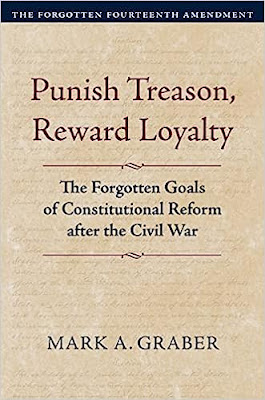
Mark A. Graber, Punish Treason, Reward Loyalty: The Forgotten Goals of Constitutional Reform after the Civil War (University of Kansas Press, 2023)
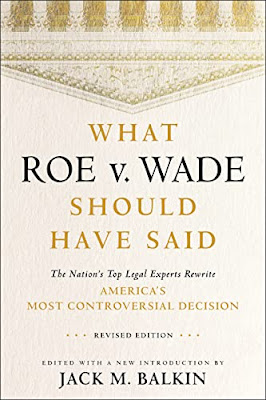
Jack M. Balkin, What Roe v. Wade Should Have Said: The Nation's Top Legal Experts Rewrite America's Most Controversial Decision - Revised Edition (NYU Press, 2023)

Andrew Koppelman, Burning Down the House: How Libertarian Philosophy Was Corrupted by Delusion and Greed (St. Martin’s Press, 2022)

Gerard N. Magliocca, Washington's Heir: The Life of Justice Bushrod Washington (Oxford University Press, 2022)
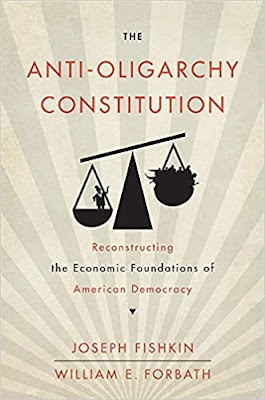
Joseph Fishkin and William E. Forbath, The Anti-Oligarchy Constitution: Reconstructing the Economic Foundations of American Democracy (Harvard University Press, 2022)
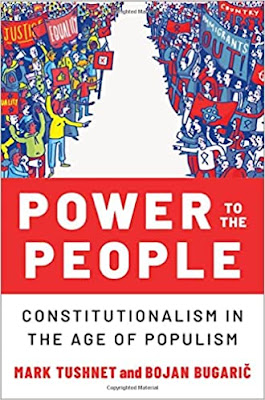
Mark Tushnet and Bojan Bugaric, Power to the People: Constitutionalism in the Age of Populism (Oxford University Press 2021).

Mark Philip Bradley and Mary L. Dudziak, eds., Making the Forever War: Marilyn B. Young on the Culture and Politics of American Militarism Culture and Politics in the Cold War and Beyond (University of Massachusetts Press, 2021).

Jack M. Balkin, What Obergefell v. Hodges Should Have Said: The Nation's Top Legal Experts Rewrite America's Same-Sex Marriage Decision (Yale University Press, 2020)

Frank Pasquale, New Laws of Robotics: Defending Human Expertise in the Age of AI (Belknap Press, 2020)

Jack M. Balkin, The Cycles of Constitutional Time (Oxford University Press, 2020)

Mark Tushnet, Taking Back the Constitution: Activist Judges and the Next Age of American Law (Yale University Press 2020).

Andrew Koppelman, Gay Rights vs. Religious Liberty?: The Unnecessary Conflict (Oxford University Press, 2020)

Ezekiel J Emanuel and Abbe R. Gluck, The Trillion Dollar Revolution: How the Affordable Care Act Transformed Politics, Law, and Health Care in America (PublicAffairs, 2020)

Linda C. McClain, Who's the Bigot?: Learning from Conflicts over Marriage and Civil Rights Law (Oxford University Press, 2020)
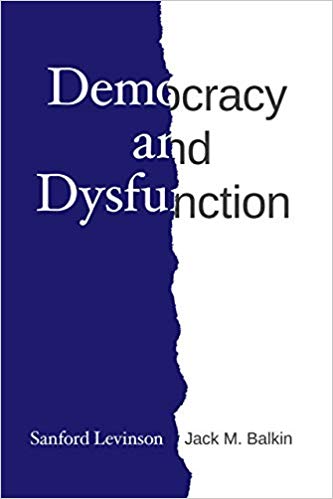
Sanford Levinson and Jack M. Balkin, Democracy and Dysfunction (University of Chicago Press, 2019)

Sanford Levinson, Written in Stone: Public Monuments in Changing Societies (Duke University Press 2018)

Mark A. Graber, Sanford Levinson, and Mark Tushnet, eds., Constitutional Democracy in Crisis? (Oxford University Press 2018)

Gerard Magliocca, The Heart of the Constitution: How the Bill of Rights became the Bill of Rights (Oxford University Press, 2018)

Cynthia Levinson and Sanford Levinson, Fault Lines in the Constitution: The Framers, Their Fights, and the Flaws that Affect Us Today (Peachtree Publishers, 2017)

Brian Z. Tamanaha, A Realistic Theory of Law (Cambridge University Press 2017)

Sanford Levinson, Nullification and Secession in Modern Constitutional Thought (University Press of Kansas 2016)

Sanford Levinson, An Argument Open to All: Reading The Federalist in the 21st Century (Yale University Press 2015)

Stephen M. Griffin, Broken Trust: Dysfunctional Government and Constitutional Reform (University Press of Kansas, 2015)

Frank Pasquale, The Black Box Society: The Secret Algorithms That Control Money and Information (Harvard University Press, 2015)

Bruce Ackerman, We the People, Volume 3: The Civil Rights Revolution (Harvard University Press, 2014)
Balkinization Symposium on We the People, Volume 3: The Civil Rights Revolution

Joseph Fishkin, Bottlenecks: A New Theory of Equal Opportunity (Oxford University Press, 2014)

Mark A. Graber, A New Introduction to American Constitutionalism (Oxford University Press, 2013)

John Mikhail, Elements of Moral Cognition: Rawls' Linguistic Analogy and the Cognitive Science of Moral and Legal Judgment (Cambridge University Press, 2013)

Gerard N. Magliocca, American Founding Son: John Bingham and the Invention of the Fourteenth Amendment (New York University Press, 2013)

Stephen M. Griffin, Long Wars and the Constitution (Harvard University Press, 2013)

Andrew Koppelman, The Tough Luck Constitution and the Assault on Health Care Reform (Oxford University Press, 2013)

James E. Fleming and Linda C. McClain, Ordered Liberty: Rights, Responsibilities, and Virtues (Harvard University Press, 2013)
Balkinization Symposium on Ordered Liberty: Rights, Responsibilities, and Virtues

Andrew Koppelman, Defending American Religious Neutrality (Harvard University Press, 2013)

Brian Z. Tamanaha, Failing Law Schools (University of Chicago Press, 2012)

Sanford Levinson, Framed: America's 51 Constitutions and the Crisis of Governance (Oxford University Press, 2012)

Linda C. McClain and Joanna L. Grossman, Gender Equality: Dimensions of Women's Equal Citizenship (Cambridge University Press, 2012)

Mary Dudziak, War Time: An Idea, Its History, Its Consequences (Oxford University Press, 2012)

Jack M. Balkin, Living Originalism (Harvard University Press, 2011)

Jason Mazzone, Copyfraud and Other Abuses of Intellectual Property Law (Stanford University Press, 2011)

Richard W. Garnett and Andrew Koppelman, First Amendment Stories, (Foundation Press 2011)

Jack M. Balkin, Constitutional Redemption: Political Faith in an Unjust World (Harvard University Press, 2011)

Gerard Magliocca, The Tragedy of William Jennings Bryan: Constitutional Law and the Politics of Backlash (Yale University Press, 2011)

Bernard Harcourt, The Illusion of Free Markets: Punishment and the Myth of Natural Order (Harvard University Press, 2010)

Bruce Ackerman, The Decline and Fall of the American Republic (Harvard University Press, 2010)
Balkinization Symposium on The Decline and Fall of the American Republic

Ian Ayres. Carrots and Sticks: Unlock the Power of Incentives to Get Things Done (Bantam Books, 2010)

Mark Tushnet, Why the Constitution Matters (Yale University Press 2010)
Ian Ayres and Barry Nalebuff: Lifecycle Investing: A New, Safe, and Audacious Way to Improve the Performance of Your Retirement Portfolio (Basic Books, 2010)
.jpg)
Jack M. Balkin, The Laws of Change: I Ching and the Philosophy of Life (2d Edition, Sybil Creek Press 2009)

Brian Z. Tamanaha, Beyond the Formalist-Realist Divide: The Role of Politics in Judging (Princeton University Press 2009)
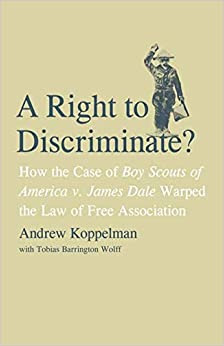
Andrew Koppelman and Tobias Barrington Wolff, A Right to Discriminate?: How the Case of Boy Scouts of America v. James Dale Warped the Law of Free Association (Yale University Press 2009)

Jack M. Balkin and Reva B. Siegel, The Constitution in 2020 (Oxford University Press 2009)
Heather K. Gerken, The Democracy Index: Why Our Election System Is Failing and How to Fix It (Princeton University Press 2009)

Mary Dudziak, Exporting American Dreams: Thurgood Marshall's African Journey (Oxford University Press 2008)

David Luban, Legal Ethics and Human Dignity (Cambridge Univ. Press 2007)

Ian Ayres, Super Crunchers: Why Thinking-By-Numbers is the New Way to be Smart (Bantam 2007)

Jack M. Balkin, James Grimmelmann, Eddan Katz, Nimrod Kozlovski, Shlomit Wagman and Tal Zarsky, eds., Cybercrime: Digital Cops in a Networked Environment (N.Y.U. Press 2007)
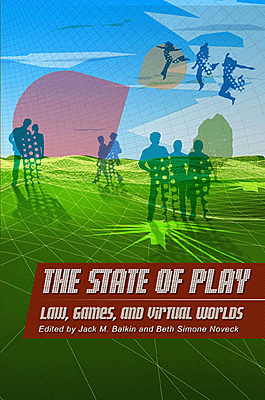
Jack M. Balkin and Beth Simone Noveck, The State of Play: Law, Games, and Virtual Worlds (N.Y.U. Press 2006)

Andrew Koppelman, Same Sex, Different States: When Same-Sex Marriages Cross State Lines (Yale University Press 2006)
Brian Tamanaha, Law as a Means to an End (Cambridge University Press 2006)
Sanford Levinson, Our Undemocratic Constitution (Oxford University Press 2006)
Mark Graber, Dred Scott and the Problem of Constitutional Evil (Cambridge University Press 2006)
Jack M. Balkin, ed., What Roe v. Wade Should Have Said (N.Y.U. Press 2005)
Sanford Levinson, ed., Torture: A Collection (Oxford University Press 2004)
Balkin.com homepage
Bibliography
Conlaw.net
Cultural Software
Writings
Opeds
The Information Society Project
BrownvBoard.com
Useful Links
Syllabi and Exams